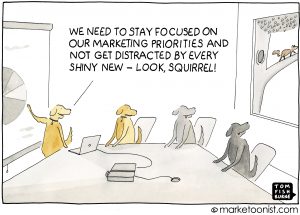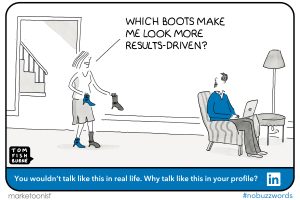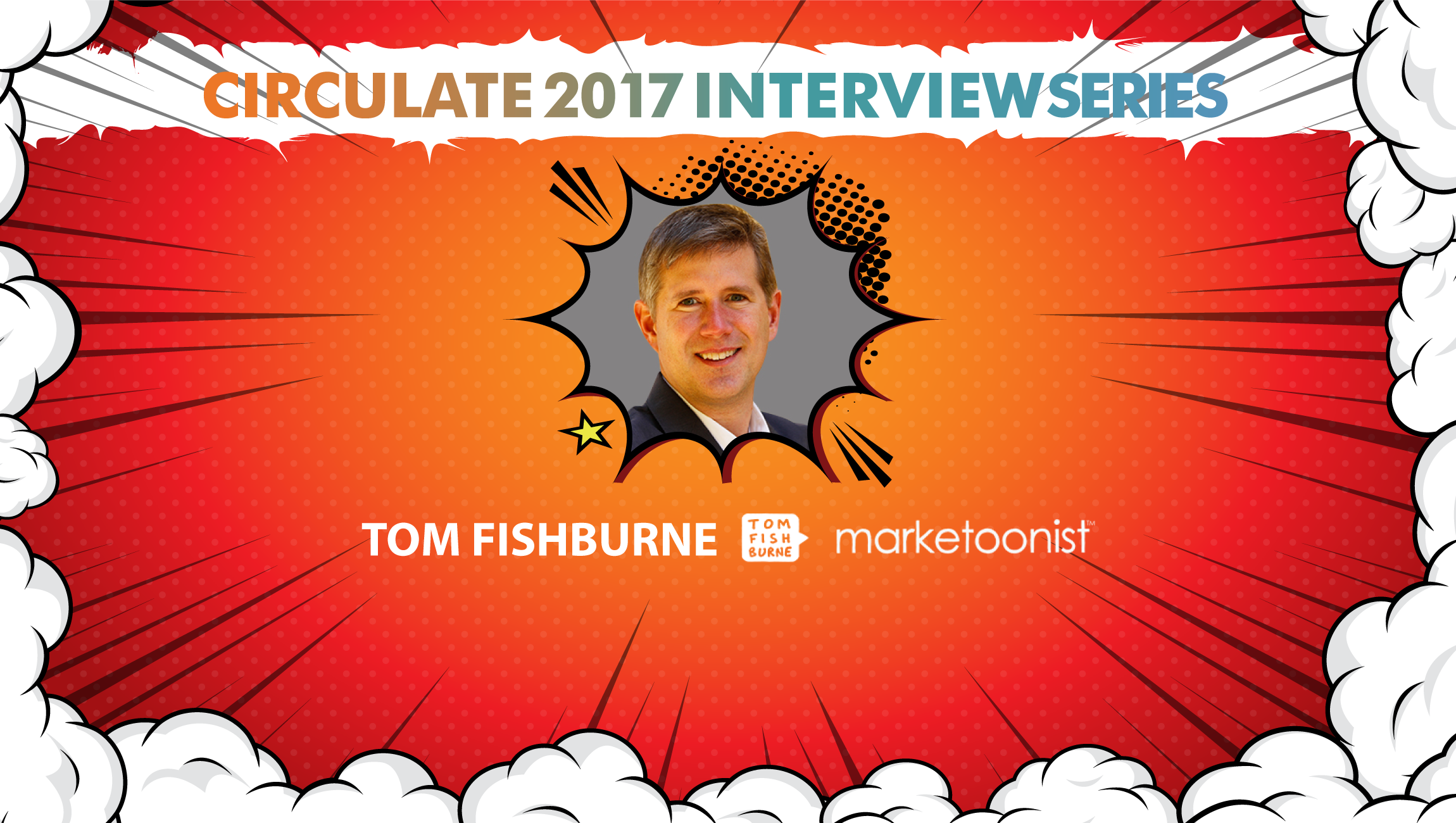“We’re in the awkward adolescence of digital advertising, where powerful tools are becoming available but our mindset hasn’t quite caught up to the potential. That’s the friction I find funniest.”
On Marketing Technology
MTS: What led you to satirize the digital advertising industry?
I started parodying all things marketing because I was working in marketing and wanted to process some of the challenges I was grappling with. Digital advertising became a natural target because there is such a tremendous learning curve. I feel like we’re in the awkward adolescence of digital advertising, where powerful tools are becoming available but our mindset hasn’t quite caught up to the potential. That’s the friction I find funniest.
MTS: What role does humor/satire play in digital marketing?
Humor is disarming and allows us to communicate hard truths. The pace of digital marketing makes it particularly important to continually question what we’re doing and to separate the shiny new things from the approaches that can create real impact. Humor reminds us that we’re all in this together.
MTS: You said that this was one the best times in history to be in marketing. Could you expound on this?
Marketers have never had more powerful tools to reach audiences and tell our stories. Every year, a  number of dizzying new technologies come along that Don Draper would have salivated over. And yet, it has also never been easier for consumers to tune out whatever we want to say to them. There’s no such thing as a captive audience. That creates a challenge, but it forces marketers to up their game, and to create things that really matter and stories that are worth sharing. It’s an incredible time to work in marketing it we accept that challenge.
number of dizzying new technologies come along that Don Draper would have salivated over. And yet, it has also never been easier for consumers to tune out whatever we want to say to them. There’s no such thing as a captive audience. That creates a challenge, but it forces marketers to up their game, and to create things that really matter and stories that are worth sharing. It’s an incredible time to work in marketing it we accept that challenge.
MTS: How important is it for a marketer to have a sense of humor?
We’re working in times of flux and uncertainty, where the rules of marketing are constantly being questioned and re-evaluated. Marketers have to laugh at ourselves to learn from what doesn’t work. We have to continually question how we’re doing our jobs. I think humor help keeps us sane while doing that.
MTS: You talk about command and control in advertising. How much of that legacy thought is still around today?
I was brought up in the model of command and control advertising. My brand management training involved crafting just the right single-minded proposition and then controlling the message as tightly as possible. I think that legacy certainly persists, although we’re no longer in the world where committees review every tweet before they go out. In more organizations, I see the new model defined as “freedom within a framework”, but the legacy of command and control is hardwired.
MTS: In this era of short attention spans, how do you believe digital marketers could engage with customers?
I think it’s less important to create individual moments of breaking through those short attention spans, and more important to invest in consistent relationships with customers over time. In a world of short attention spans, there’s opportunity is thinking “serial” rather than “viral” — an ongoing cadence of communication where customers look forward to the next installment.
MTS: Why do you say that technology can’t save a boring idea?

It’s tempting to get excited about the next shiny new thing, but this can lead to using technology as a crutch. I think that technology can amplify and extend ideas, but it can’t stand in place of ideas. Every organization has access to the same technology. It’s what marketers do with that technology that matters.
MTS: What startups are you watching/keen on right now?
I’m a big fan of Betabrand, a startup clothing company that describes themselves as “1% Fashion, 99% Fiction”. They set the bar high for storytelling, bootstrapping, and using digital tools to amplify their message to punch harder than their weight.
MTS: What tools does your marketing stack consist of in 2017?
With our client projects, the marketing stack really varies based on the size and complexity of the company. We recently worked with Marketo on a cartoon series about Account-Based Marketing that was managed and monitored by their own ABM Marketing Stack (how meta is that?) For our own Marketoonist cartoons, we use a relatively simple marketing stack with Mailchimp, Hootsuite, Google Analytics, WordPress, and Insightly.
MTS: Would you tell us about your standout digital campaign? (Who was your target audience and how did you measure success?)
 We worked with LinkedIn on an effective cartoon campaign designed to get business professionals to rethink LinkedIn profiles. Using the insight that people use too many buzzwords in their profiles, we created a series imagining if people talked in real-life like they do in their profiles. For example, a woman asked her husband which boots made her look “more results-driven.” The cartoons were translated into a dozen different languages, syndicated one-at-a-time in LinkedIn markets around the world, and also collected in a Slideshare with survey data about buzzword use. The campaign more than tripled expected engagement rates.
We worked with LinkedIn on an effective cartoon campaign designed to get business professionals to rethink LinkedIn profiles. Using the insight that people use too many buzzwords in their profiles, we created a series imagining if people talked in real-life like they do in their profiles. For example, a woman asked her husband which boots made her look “more results-driven.” The cartoons were translated into a dozen different languages, syndicated one-at-a-time in LinkedIn markets around the world, and also collected in a Slideshare with survey data about buzzword use. The campaign more than tripled expected engagement rates.
MTS: How do you prepare for an AI-centric world as a business leader?
Part of being a cartoonist parodying the issues of the day is to comfortably admit when I don’t know the answer. I honestly don’t know how an AI-centric world will play out for business leaders, but I love brainstorming the potential pitfalls. One of my favorite cartoon themes is to exaggerate a future based on what is happening right now. For example, I illustrated a future conversation with a creepy version of Alexa. In general, though, I think it’s more important than ever for business leaders to define for themselves was it is that they uniquely do. That definition will continually change in an AI-centric world.
This Is How I Work
MTS: One word that best describes how you work.
Playful
MTS: What apps/software/tools can’t you live without?
From a drawing perspective, I love drawing by hand, but I certainly use Photoshop throughout. WordPress and Mailchimp are indispensable to getting my cartoons into the world. Hootsuite and Google Analytics help me monitor how cartoons are resonating. Insightly is the backbone of business development in our studio.
MTS: What’s your smartest work related shortcut or productivity hack?
This is decidedly low-tech, but I carve out the first two hours of every day for deep-thinking creative time, with my mobile on Airplane mode and no digital distractions. I primarily use this time for cartoon idea generation, but it also grounds me for the twists and turns that come later in my day. It makes me more productive not only by providing the headspace for creative thinking, but also making me focused on what matters later in the day.
MTS: What are you currently reading? (What do you read, and how do you consume information?)
I usually have one non-fiction book (currently “On Writing”, by Stephen King) and one fiction book (currently “A Man Called Ove” by Fredrik Backman) going at a time. This is in addition to the short-form New Yorker, New York Times, and other reading that I snack on throughout the week.
MTS: What’s the best advice you’ve ever received?
Draw your V-1 marker. That’s the point of no return on a runway where a plane either takes off or it crashes. When I was wondering when to take the entrepreneurial leap to start my own business, David Hieatt of Hiut Denim advised me to draw my own V-1 marker. In other words, he urged me to write down what would have to be true in the future to make that leap. It took the emotion out of it. One I hit that marker, I jumped.
MTS: Tag the one person in the industry whose answers to these questions you would love to read:
Chris Lindland, Founder of Betabrand
MTS: Thank you Tom! That was fun and hope to see you back on MarTech Series soon.
Tom started drawing cartoons on the backs of business cases as a student at Harvard Business School in 2000. His cartoons have grown by word of mouth to reach several hundred thousand marketers every week and have been featured by the Wall Street Journal, Fast Company, and the New York Times.
In 2010, He started Marketoonist, a content marketing agency focused on the unique medium of cartoons. Marketoonist create content marketing with a sense of humor for businesses such as Google, IBM, Kronos, and LinkedIn. Marketoonist is expanding with a range of cartoonists from the New Yorker and nationally syndicated strips.
Marketoonist is a cartoon studio focused on content marketing with a sense of humor. We create marketoon campaigns designed to be content worth sharing. We’ve created content marketing campaigns for large organizations such as Google, Kronos, and GE, and start-up organizations such as Baynote, Lifestreet Media, and Get Satisfaction.
Marketoonist is expanding with a variety of cartoonists from the New Yorker and nationally syndicated strips. Marketoonist taps the talent pool of the world’s cartoonists for brands that need storytelling.
The MTS Martech Interview Series is a fun Q&A style chat which we really enjoy doing with martech leaders. With inspiration from Lifehacker’s How I work interviews, the MarTech Series Interviews follows a two part format On Marketing Technology, and This Is How I Work. The format was chosen because when we decided to start an interview series with the biggest and brightest minds in martech – we wanted to get insight into two areas … one – their ideas on marketing tech and two – insights into the philosophy and methods that make these leaders tick.



